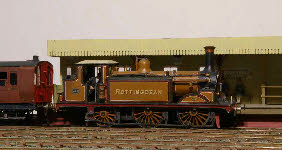



Last updated April 2024
November 2023
Scenery
We have painted the base of the river using Woodland Scenics drab olive colour, but it needs a bit of variation, so the work here has paused while we source more paint.
 In the meantime we have done some work at the back of the layout, creating a track and a grassy bank, with a couple of trees on it, to provide a bit of contrast with the industrial colours of the wharf side.
In the meantime we have done some work at the back of the layout, creating a track and a grassy bank, with a couple of trees on it, to provide a bit of contrast with the industrial colours of the wharf side. Backscene
BacksceneWe’ve been giving a lot of thought to the backscene: curved corners to minimise shadows, and some ideas on how to conceal the entrance onto the layout from the fiddle yard.
Fiddle yard
The dimension of the fiddle yard have been finalised, so we’ve made a start cutting out the parts. The cassettes have all been completed, and the dimensions of the stock boxes (which will carry the cassettes and stock) have been finalised.
Lighting
We will be using the lighting originally made for Brighton Road 20 years ago, and now also used on Plumpton Green.
Trackwork
We continue to work on improvements to the trackwork, ironing out any minor mis-
December 2023
Scenery
The river base has been given another coat of paint, and now looks ok. The acrylic sheet has been cut to size, and is ready for fixing in place. We only get one go at this, so a bit of experimentation is in hand to determine the best technique and the best glue to use.

 Backscene
Backscene The backscene has been finished and painted with white undercoat. We’ve been experimenting with some different colour blues (emulsion match pots) to give the appearance of wispy cloudy sky. The curved corners work well, and the exit from the fiddle is complete.
 Fiddle yard
Fiddle yardThe fiddle yard is now finished, with space to rotate three cassettes, and storage for spare locos and stock.
Lighting
Two of the Plumpton lighting standards work perfectly without modification whilst the third is a spare from Brighton Road, and requires a little adaptation to fit around the fiddle yard. As with Plumpton, the ‘pelmet’ will rest on the ends of the lighting standards.
 Buildings
BuildingsWe have a lot of work to do on buildings, and Chris has made a start on the small engine shed (just big enough to house one of the engines). A start has also been made on the weighbridge building. Both this and the engine shed have been drawn using Turbocad, and then marked out on brick plasticard using the Silhouette cutter. The doors of the engine shed will be motorised, so we have made the door frame from square brass tube. One window has been cut out using the Silhouette cutter and is temporarily in place to check for size, before cutting out the remaining three windows.
January 2024
Lighting

 The lighting standards have been adjusted to suit, and fitted. They are very simple ‘gallows’ design which fold up neatly for transport. They fix onto the baseboards using long bolts through the base board corner blocks. All the old filament bulbs have been replaced with (virtually unbreakable) LEDs.
The lighting standards have been adjusted to suit, and fitted. They are very simple ‘gallows’ design which fold up neatly for transport. They fix onto the baseboards using long bolts through the base board corner blocks. All the old filament bulbs have been replaced with (virtually unbreakable) LEDs.Pelmet
The pelmet has now been put together (recycling some of the plywood from the Pulborough fiddle yards). This will eventually have the name ‘Ouse Wharf’ added in large cut-
Scenery
 We’ve spent quite a while experimenting with ways of fixing down the acrylic sheet for the water. The initial approach was to paint the plywood base in appropriate muddy water colours, and glue the acrylic in place using epoxy, or perhaps PVA. Neither of these solutions works because the glue can be clearly seen between the acrylic and the plywood.
We’ve spent quite a while experimenting with ways of fixing down the acrylic sheet for the water. The initial approach was to paint the plywood base in appropriate muddy water colours, and glue the acrylic in place using epoxy, or perhaps PVA. Neither of these solutions works because the glue can be clearly seen between the acrylic and the plywood.The solution adopted is to paint the underside of the acrylic in muddy water colours (Woodland scenics olive drab, moss green and yellow silt) and to use epoxy along the edges to fix it down.
Loco shed
 Work on the loco shed is making progress, with all the windows cut out, and the roof underway.
Work on the loco shed is making progress, with all the windows cut out, and the roof underway.February 2024
Wharf wall
 With both sections of the acrylic sheet for the river in place, we’ve made a start on the wharf wall. I thought this would take many hours to complete, but we managed to complete it within a couple of weeks. The wall and timber uprights were given a first coat of paint before fixing in place, and will be suitably weathered when we get around to it.
With both sections of the acrylic sheet for the river in place, we’ve made a start on the wharf wall. I thought this would take many hours to complete, but we managed to complete it within a couple of weeks. The wall and timber uprights were given a first coat of paint before fixing in place, and will be suitably weathered when we get around to it.The wall is made from Will’s random stone sheets, and the uprights are obeche. There is a lot of weathering, highlighting and detail to add.
Running
Whilst we’ve been working on the various scenic elements we’ve also spent an hour or two each week running the layout to make sure everything works well and nothing derails. We continue to find a few minor imperfections with rail misalignment (both vertical and horizontal) which we are fixing as we find them. We’ve also found a couple more poorly soldered wiring connections which have now been fixed. A few adjustments have been made to the operation of the turnouts. The adaptations (described in August above) have proved invaluable in making small adjustments to the throw of the switch-
Tramway
The track in the central section of the layout will be ‘tramwayed’ (filled with timber or setts in the four-








